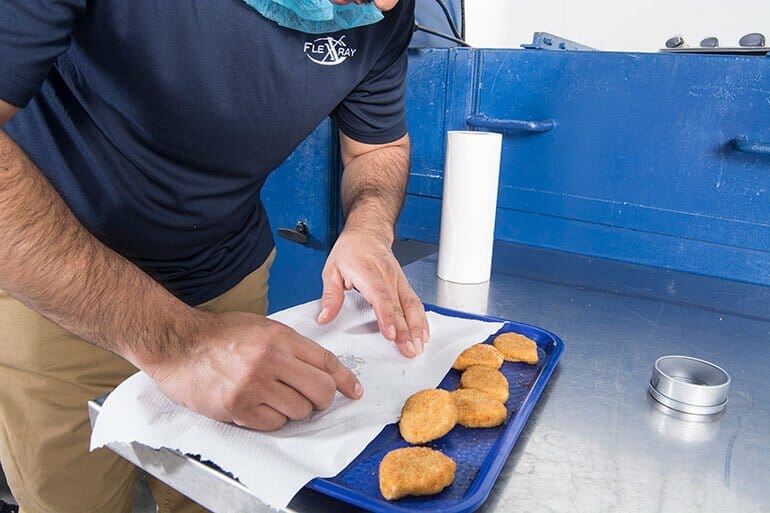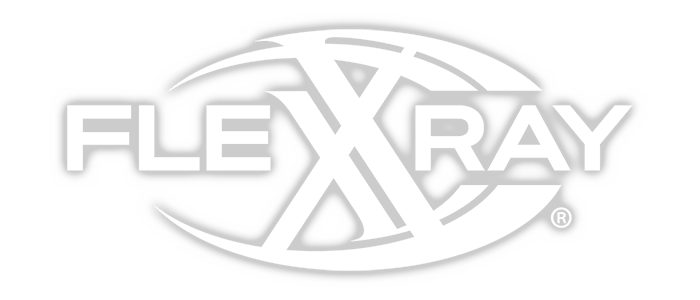
No food manufacturer wants to deal with contaminated product, but when foreign material contamination happens, they need to have a process in place. Foreign material in food is something that occurs in many different ways and at every stage of the production process.
Contaminants can make their way into food in the field, during transportation to the production facility or at numerous points in the manufacturing process; they can be caused by anything from human error to mechanical failure.
Regardless of how the foreign material gets into the food, the big concern for plant management is the same: What should the next steps be?
Protecting the Food Supply
X-ray food inspection allows manufacturers to learn the exact size and scope of the contamination problem and eliminate the chance of contaminated food reaching consumers. When a manufacturer ships product to FlexXray, the inspection can be completed within just a few hours of its arrival if needed. The experienced team of technicians, utilizing custom medical-grade technology, can clearly identify the product that is contaminated and segregate it from product that is safe for distribution.
Once a manufacturer is made aware of the scope of their food contamination issue, it’s important that they know what options are available next and what the results of each action could be. They can distribute the product that isn’t contaminated, but what should be done with the product that was segregated for potential foreign material contamination?
FlexXray offers choices to manufacturers facing this situation, and has processes in place to streamline the next steps the manufacturer decides to take. Here’s a closer look at each of those solutions and how they can affect operations.
{{cta(’82e8e8b2-a590-4b5a-befa-b05127c374b3′,’justifycenter’)}}
Option 1: Return the suspect product to the manufacturing facility
In some cases, once manufacturers have confirmed that the contamination exists, they will request to have it returned to their facility. This product is segregated, marked with red tape and returned on the back of the truck.
However, once the product is back in their hands, the company still has a few potential problems to work through in order to decide what the next steps need to be.
Without the use of the same technology at their own facility, the company management team will be forced to “dissect” and pinpoint the actual contamination on their own; many times they are looking for contamination smaller than 1mm in size.
The facility will also have to ensure proper protocols are in place to avoid this product accidentally being introduced back into the distribution stream. The opportunity of this product being re-introduced to end consumers through distribution channels is extremely risky with this option.
Finally, the facility will ultimately have to dispose of the contaminated product. The FDA, state and local laws directly affect how food product is disposed of. In addition to acquiring the proper permits to discard the contaminated product, the company must find the proper facility that will accept and dispose of the product. They also must arrange for the safe transportation of that product to the landfill, rendering plant or incinerator that will dispose of it.
Option 2: Destroy the product
Manufacturers who want to avoid the cost and risk of having the contaminated product shipped back to them, as well as eliminate the hassle of having to dispose of it themselves, can choose to have it destroyed. FlexXray has the proper documentation required to dispose of contaminated product and will provide an AOD for all impacted product, which saves the food manufacturer time, money and paperwork.
However, this option also comes with certain challenges. Disposing of the contaminated food means producers won’t have the physical contaminant catalogue. Validation and traceability are essential to pinpoint exact contaminant type and exactly where problems exist. When the product is simply disposed of, so is the evidence that might be important to the company in finding where the problem originated.
Without having the food dissected and the physical hazard removed and documented, there’s no real way to know.
Option 3: Use FlexXray’s contaminant retrieval service
Contaminant retrieval allows manufacturers to glean more information and insight into the exact type, sizes and cause of the contamination. This additional service takes all of the suspect product that was segregated throughout the initial inspection and then performs a secondary inspection in order to manually dissect the product, remove the contaminant and catalogue the results for plant management. This detailed report documents the pallet, batch/lot, bag/container time, contaminant type and the two-dimensional size of each contaminant found through initial inspection.
This service is done within 24 hours of inspection completion. The catalogue is scanned and an electronic copy is emailed upon completion, then the original documentation is shipped directly overnight, providing customers with the physical contamination in hand within 48 hours.
Advantages of contaminant retrieval
- Contaminant retrieval allows food producers to maintain traceability throughout the entire inspection process.
- Traceability provides accountability; being able to identify the physical hazards in food can pinpoint where the contamination originated and the overall scope of the problem.
- When contamination is the result of human or mechanical error within the manufacturing facility, it provides managers with perspective on where problems exist so they can focus on changing and improving those areas.
- If the contamination occurred before ingredients reached the manufacturing facility, this process provides food producers with the documentation required to approach suppliers with substantiated proof of contamination; they may even be able to recoup the cost of the X-ray inspection and contamination removal.
- Most importantly, it informs food manufacturers as to where the weak links exist in their food chain, and could affect their choice of food suppliers.
When it comes to food production, safety should always be a top priority for manufacturers. Being able to document where contaminants originated can give them the insight necessary to implement additional safety measures, change relationships with suppliers and vendors or take whatever other action is required to ensure safety.

Leave a Reply
You must be logged in to post a comment.